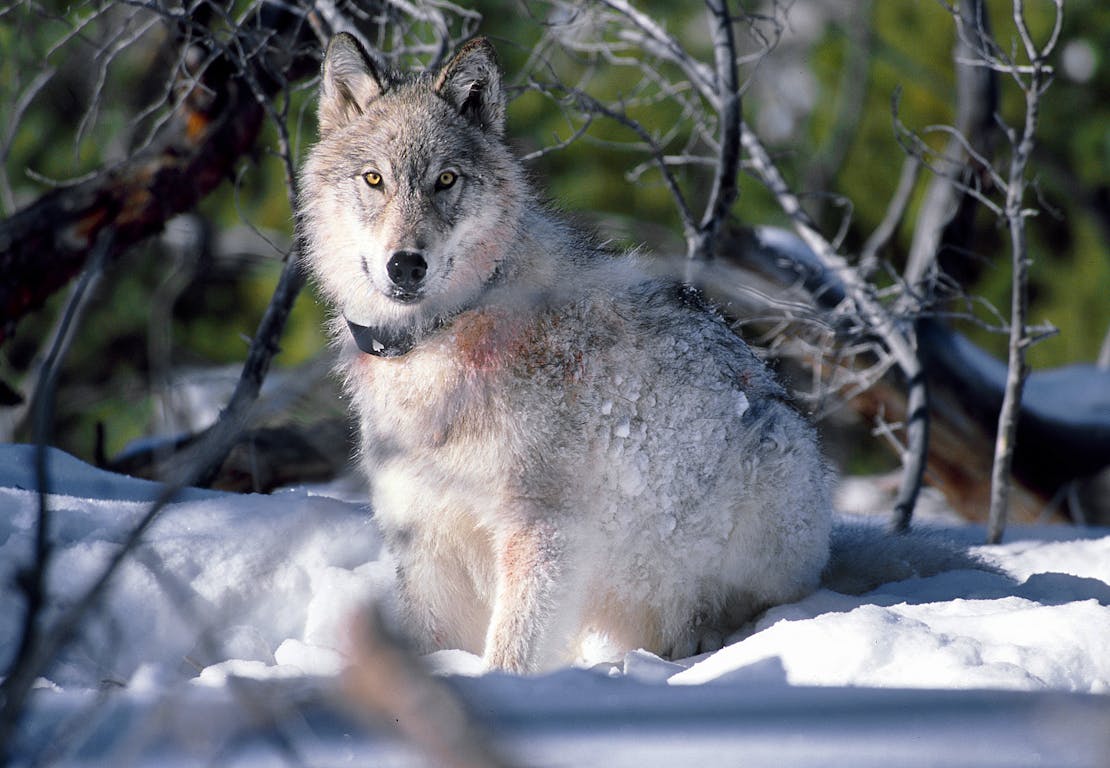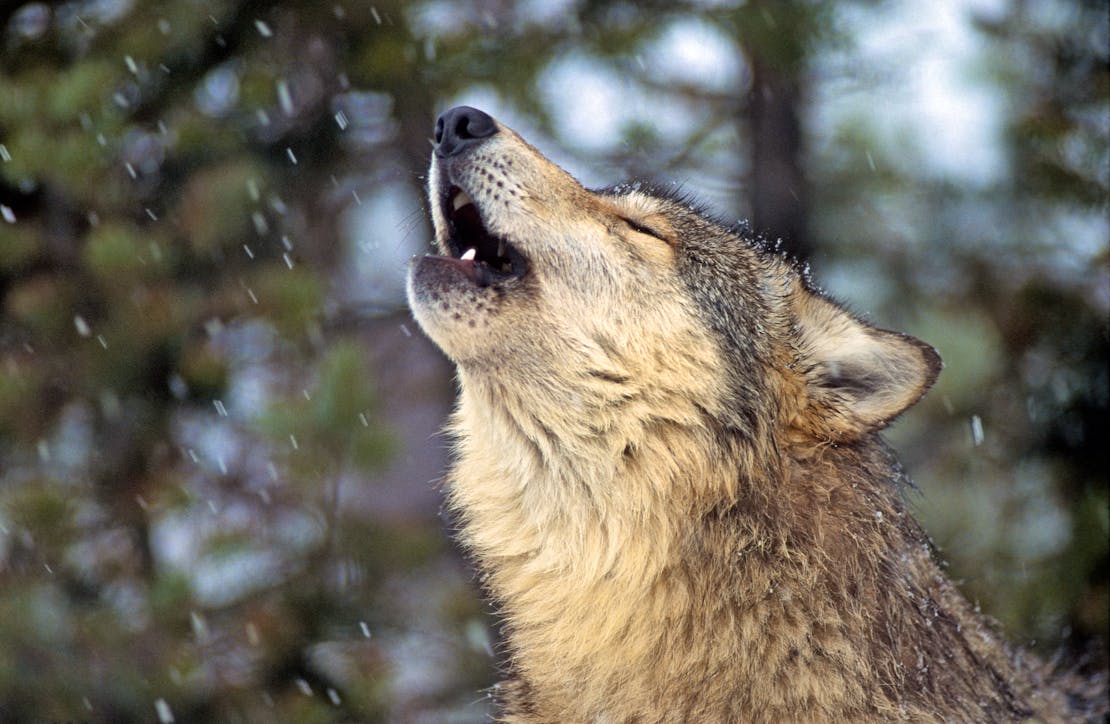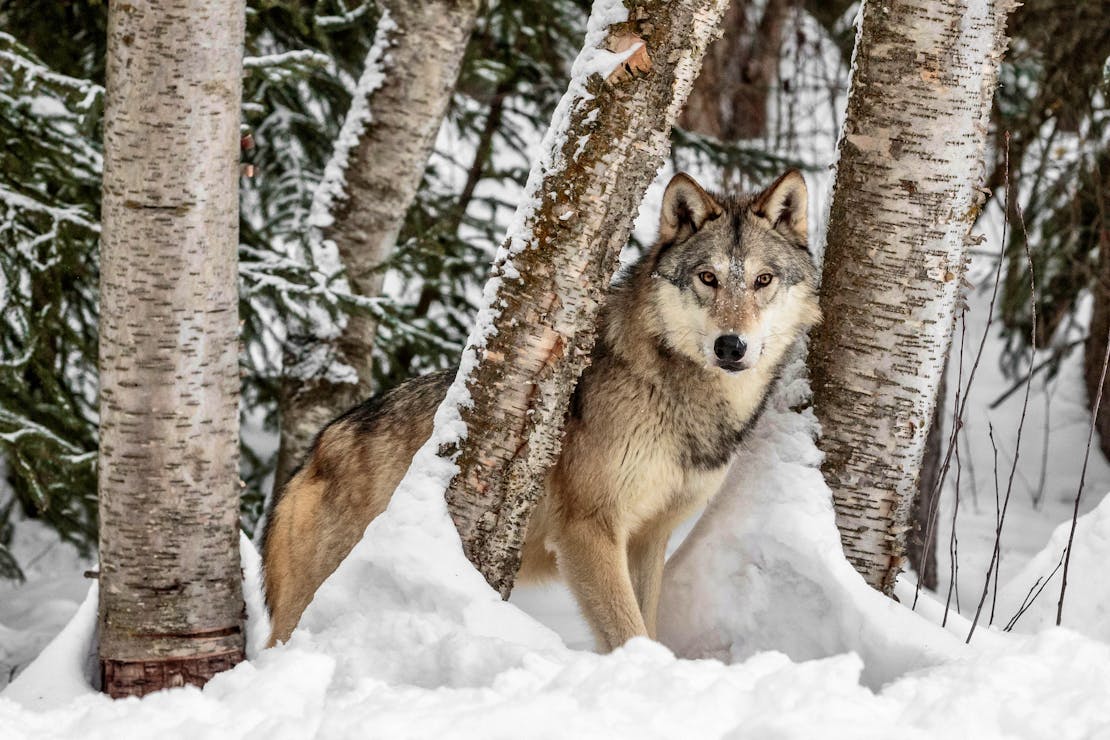Everyone is talking about gray wolves. It could be because Miley Cyrus recently said she’ll use her fame to fight for wolves, or because of Montana's controversial push to dramatically expand wolf hunting in the state. But it could also be because of a developing storyline in Season 5 of the hit TV series Yellowstone. For those who haven’t watched, I’ll get you quickly up to speed.
The show follows John Dutton, played by Kevin Costner, and his ranch, the Yellowstone. The ranch employs several cowboys who are charged with taking care of the ranch and its cattle, and face immense, and sometimes ridiculously dramatic, obstacles along the way. There’s murder of course, and romance, and all the other Hollywood written scenes that garner the attention of roughly 10 million viewers a week.
This season, the show’s events hit close to home for Defenders of Wildlife. While out riding in Episode 2, ‘The Sting of Wisdom,’ the cowboys find a mother cow that’s been killed by wolves... or so it seems. Later that night, two of the cowboys are sent to hunt the wolves and find them lurking around more Yellowstone cattle. The cowboys shoot them from far away, using thermal goggles. As the cowboys approach the dead wolves, they discover that some of the pack is wearing GPS collars.
The GPS collars mean these are Yellowstone National Park wolves. If the public finds out that Dutton cowboys have killed national park wolves, John Dutton and his cowboys could be in big trouble. “These wolves have Facebook pages!” one of the cowboys exclaims.
This closely mirrors wolf conservation in the Yellowstone area today. The wolves are held in high esteem by the public as a great American conservation success story. They’re fully protected within the park but open to hunting and trapping when they roam beyond the park’s boundaries.
When Congress first established Yellowstone National Park in the late 19th century, gray wolves thrived across the landscape. But due to a concerted effort to eradicate them, by the mid-1900s, wolves had been almost entirely eliminated from the lower 48 states.
The reintroduction of wolves to Yellowstone happened in 1995. Our CEO at the time was there. Since the initial reintroduction, Defenders has remained committed to restoring wolves to additional suitable places throughout their historical range and to promoting coexistence in these places.
Though we are excited to see some of the intricacies of our everyday work play out onscreen to a large audience, we want to make sure viewers and fans have all the facts about the history of gray wolves and what really goes on in Montana.
Myth: Ranchers Can’t Coexist with Wolves
A primary conflict some ranchers have with wolves pertains to the loss of livestock—even though far less than one tenth of one percent of livestock in wolf-occupied areas are lost to wolves. Though very few ranchers actually experience livestock losses to wolves, it can be significant for the ranch being impacted.
Defenders has extensive experience in coexistence—promoting and implementing effective nonlethal tools and techniques to reduce conflicts between wildlife and livestock throughout the country. For example, by training mother cows to stay with their calves and to find security in the herd when threatened, it is possible to rekindle the herd instincts of cattle; instincts which keep them safer from predators. Because wolves are fearful of humans, an active human presence on the range can also be invaluable. Range riders patrol where livestock graze, deter predators and keep tabs on the herd to ensure its health and well-being.
Additional tools include the use of specialized fence flagging called turbo-fladry, randomized strobe lights like Foxlights, and noise makers to discourage wolves from getting too close to livestock. More information on these strategies to reduce conflicts can be found in Defenders’ own Livestock and Wolves: Guide to Nonlethal Tools and Methods to Reduce Conflicts.
Fact: The Reintroduction of Wolves Benefited Yellowstone
The changes in the park since wolves were reintroduced on January 12, 1995, have been exciting and significant. Wolf reintroduction helped to rebalance elk and deer populations and caused them to move across the landscape more, allowing willows and aspen to rebound on the landscape. The reduced overgrazing stabilized riverbanks, improving water quality. Songbirds benefited from these changes as did beavers, eagles, foxes and badgers. And, while the restoration of wolves in Yellowstone has cost about $30 million total, wolf ecotourism brings in $82 million annually.
Myth: Wolves Have More Protections Now Than in 1995
Over the past decade, the federal government has slowly removed federal protections for gray wolves, starting with wolves in the northern Rocky Mountains in 2011. In November 2020, the U.S. Fish and Wildlife Service announced its decision to remove federal protections for gray wolves throughout the remaining Lower 48 states, despite a dearth of scientific evidence to justify the move.
The decision, which took effect on January 4, 2021, affected gray wolves in at least 44 states, most prominently in the western Great Lakes, the central Rockies and Pacific Coast. The removal of protections had immediate consequences for wolves, leaving them vulnerable to unsustainable hunting, trapping and other lethal measures. Wolf protections were reinstated earlier this year for wolves, except for the Northern Rocky Mountains area of Montana, Idaho and Wyoming, including the areas surrounding Yellowstone National Park. During the 2021-2022 hunting season, 24 wolves from the Park were killed in neighboring states. Hundreds more were killed across all three states—roughly 270 in Montana, 500 in Idaho and 30 in Wyoming. Sadly, Montana and Idaho have been actively producing new laws to remove protections for wolves.
Fact: Montana Recently Passed Laws Encouraging More Killing of Wolves
Montana was given authority to manage wolves throughout the state upon the federal delisting of the Rocky Mountain gray wolf population from the Endangered Species Act. In 2021, the Montana Legislature passed four aggressive wolf management bills that authorized reimbursement for wolf hunters and trappers, increased the season length for trapping, increased bag limits, and permitted formerly banned hunting and trapping methods such as neck snares, use of bait and hunting at night with spotlights. Last year’s wolf hunt, one of the most aggressive in modern Montana history, culminated in the deaths of one-fifth of Yellowstone National Park’s entire wolf population, with some three-quarters of those killed in Montana.
In contrast, Colorado is preparing to reintroduce gray wolves to the state, thanks to a voter-approved initiative to begin reintroduction of the species no later than the end of 2023. This marks the first time a state’s voters, not federal wildlife managers, have directed the return of wolves. The state wildlife agency also lists wolves as endangered with full protections.
Unfortunately, in November of this year, three wolves believed to be pups from the North Park pack in Colorado, were killed when they crossed state lines into Wyoming, where it is legal to kill wolves. The North Park pack produced six pups in late April or early May 2021 in Jackson County—the first to be born in Colorado in around 80 years—not far from the Wyoming border. It is not uncommon for the North Park pack to travel into and out of Wyoming. Wolf packs usually hunt within a specific territory. Sometimes these territories can be as large as 50 square miles, but they may even travel more than 1,000 miles in areas where prey is scarce. Wolves need to be able to travel freely throughout their range in order to survive and thrive. Their livelihood shouldn’t depend on state boundaries.
Fact: Radio Collared Wolves Are Important for Research and Tracking
Since the reintroduction of gray wolves to Yellowstone, radio collars have been used as the main tool for research and monitoring the whereabouts of the species. Now, more than 25 years later, radio-collaring remains an important method to collect all kinds of data. CollaRed Wolves can also provide important information to wildlife managers and help provide tools for conflict deterrence with livestock operations. Wolves wearing radio collars do not act any differently than wolves without radio collars—there’s no evidence suggesting collars influence rates of dispersal, mortality, survival, breeding success and leadership.
The fate of the Dutton cowboys is still unknown, but we hope you have a better understanding of why their actions may have serious consequences.
In the real world, the fate of gray wolves is in the hands of the U.S. Fish and Wildlife Service (FWS). The agency is currently conducting a review to weigh reinstating federal Endangered Species Act protections for gray wolves in the northern Rockies. In September 2021, FWS announced it would be exploring relisting after finding “substantial, credible information indicating that a listing action may be warranted” in an initial assessment. The agency is overdue in issuing that review, which was supposed to be completed within a year.













Follow Defenders of Wildlife
facebook bluesky twitter instagram youtube tiktok threads linkedin